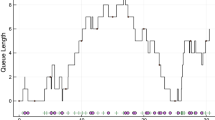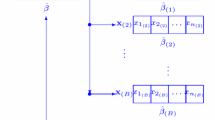Abstract
We study the robustness of performance predictions of discrete-time finite-capacity queues by applying the framework of imprecise probabilities. More concretely, we consider the Geo/Geo/1/L model with probabilities of arrival and departure that are no longer fixed, but are allowed to vary within given intervals. We distinguish between two concepts of independence in this framework, namely repetition independence and epistemic irrelevance. In the first approach, we assume the existence of time-homogeneous probabilities for arrival and departure, which leads us to consider a collection of stationary queues. In the second, the stationarity assumption is dropped and we allow the arrival and departure probabilities to vary from time point to time point; they may even depend on the complete history of queue lengths. We calculate bounds on the expected queue length, the probability of a particular queue length and the probability of turning on the server. For the expected queue length, both approaches coincide. For the other performance measures, we observe and discuss various differences between the bounds obtained for these two approaches. One of our observations is that ergodicity may break down due to imprecision: bounds on expected time averages of certain functions on the state space are not necessarily equal to the bounds on the expectation of that function at random instants in a steady-state queue.










Similar content being viewed by others
Notes
A good overview can be obtained by perusing the proceedings of the biennial ISIPTA conferences at www.sipta.org.
References
Alfa, A.S.: Queueing Theory for Telecommunications: Discrete Time Modelling of a Single Node System, 1st edn. Springer, New York (2010)
Altman, E., Avrachenkov, K.E., Núñez-Queija, R.: Perturbation analysis for denumerable Markov chains with application to queueing models. Adv. Appl. Prob. 36, 839–853 (2004)
Augustin, T., Coolen, F.P., De Cooman, G., Troffaes, M.C. (eds.): Introduction to Imprecise Probabilities. Wiley (2014)
Boole, G.: Studies in Logic and Probability. Dover Publications, Mineola (2004, reprint of the work originally published by Watts & Co., London, in 1952)
Bucklew, J.A., Ney, P., Sadowsky, J.S.: Monte Carlo simulation and large deviations theory for uniformly recurrent Markov chains. J. Appl. Prob. 27, 44–59 (1990)
Cao, X.R., Chen, H.F.: Perturbation realization, potentials, and sensitivity analysis of Markov processes. IEEE Trans. Autom. Control 42(10), 1382–1393 (1997)
Chaudhry, M.L.: On numerical computations of some discrete-time queues. In: Computational Probability, Chap. 10, pp. 365–408. Springer (2000)
Couso, I., Moral, S., Walley, P.: A survey of concepts of independence for imprecise probabilities. Risk Decis. Policy 5(02), 165–181 (2000)
De Cooman, G., De Bock, J., Lopatatzidis, S.: A pointwise ergodic theorem for imprecise Markov chains. In: Augustin, T., Doria, S., Miranda, E., Quaeghebeur E. (eds.) ISIPTA ’15—Proceedings of the Ninth International Symposium on Imprecise Probability: Theories and Applications, pp. 107–116. Aracne Editrice (2015)
De Cooman, G., Hermans, F., Antonucci, A., Zaffalon, M.: Epistemic irrelevance in credal networks: the case of imprecise Markov trees. In: Augustin, T., Coolen, F.P.A., Moral, S., Troffaes, M.C.M. (eds.) ISIPTA ’09—Proceedings of the Sixth International Symposium on Imprecise Probability: Theories and Applications, pp. 149–158. SIPTA, SIPTA, Durham,(2009). http://www.sipta.org/isipta09/proceedings/053.html
De Cooman, G., Hermans, F., Quaeghebeur, E.: Imprecise Markov chains and their limit behaviour. Prob. Eng. Inf. Sci. 23(4), 597–635 (2009). doi:10.1017/S0269964809990039. arXiv:0801.0980
De Bock, J., De Cooman, G.: An efficient algorithm for estimating state sequences in imprecise hidden Markov models. J. Artif. Intell. Res. 50, 189–233 (2014)
Gross, D., Shortle, J.F., Thompson, J.M., Harris, C.M.: Fundamentals of Queueing Theory. Wiley, New York (2013)
Hermans, F., De Cooman, G.: Characterisation of ergodic upper transition operators. Int. J. Approximate Reasoning 53(4), 573–583 (2012). doi:10.1016/j.ijar.2011.12.008
Kemeny, J.G., Snell, J.L.: Finite Markov Chains. Undergraduate Text in Mathematics. Springer, New York (1976). Reprint of the 1960 Edition
Keynes, J.M.: A Treatise on Probability. Macmillan, London (1921)
Levi, I.: The Enterprise of Knowledge. MIT Press, London (1980)
Quaeghebeur, E.: Learning from samples using coherent lower previsions. Ph.D. thesis, Ghent University (2008)
Rubinstein, R.Y.: Optimization of computer simulation models with rare events. Eur. J. Oper. Res. 99(1), 89–112 (1997)
Schweitzer, P.J.: Perturbation theory and finite Markov chains. J. Appl. Prob. 5, 401–413 (1968)
Seidenfeld, T., Schervish, M.J., Kadane, J.B.: Rethinking the Foundations of Statistics. Cambridge University Press, Cambridge (1999)
Shafer, G.: A Mathematical Theory of Evidence. Princeton University Press, Princeton (1976)
Shafer, G.: The Art of Causal Conjecture. The MIT Press, Cambridge (1996)
Smith, C.A.B.: Consistency in statistical inference and decision. J. Royal Stat. Soc. A 23, 1–37 (1961)
Troffaes, M.C.M., De Cooman, G.: Lower Previsions. Wiley, New York (2014)
Škulj, D., Hable, R.: Coefficients of ergodicity for Markov chains with uncertain parameters. Metrika 76(1), 107–133 (2013). doi:10.1007/s00184-011-0378-0
Walley, P.: Statistical Reasoning with Imprecise Probabilities. Chapman and Hall, London (1991)
Walley, P.: Inferences from multinomial data: learning about a bag of marbles. J. Royal Stat. Soc. B 58, 3–57 (1996). With discussion
Walley, P.: Towards a unified theory of imprecise probability. Int. J. Approximate Reasoning 24, 125–148 (2000)
Weichselberger, K.: The theory of interval-probability as a unifying concept for uncertainty. Int. J. Approximate Reasoning 24, 149–170 (2000)
White, J.A.: Analysis of Queueing Systems. Elsevier, Amsterdam (2012)
Whittle, P.: Probability Via Expectation, 4th edn. Springer, New York (2000)
Williams, P.M.: Notes on conditional previsions. Technical report, School of Mathematical and Physical Science, University of Sussex (1975). Revised journal version: [35]
Williams, P.M.: Indeterminate probabilities. In: M. Przelecki, K. Szaniawski, R. Wojcicki (eds.) Proceedings of a 1974 Conference Held in Warsaw. Formal Methods in the Methodology of Empirical Sciences, pp. 229–246. Reidel, Dordrecht (1976)
Williams, P.M.: Notes on conditional previsions. Int. J. Approximate Reasoning 44, 366–382 (2007). Revised journal version of [33]
Xia, L., Cao, X.R.: Performance optimization of queueing systems with perturbation realization. Eur. J. Oper. Res. 218, 293–304 (2012)
Zadeh, L.A.: Fuzzy sets. Inf. Control 8(3), 338–353 (1965)
Acknowledgments
Research for this paper by Stavros Lopatatzidis, Gert de Cooman, Stijn De Vuyst and Joris Walraevens was funded through project number 3G012512 of the Research Foundation Flanders (FWO). Jasper De Bock is a PhD Fellow of the FWO and wishes to acknowledge its financial support. The authors would also like to thank three anonymous referees for their many helpful suggestions.
Author information
Authors and Affiliations
Corresponding author
Appendices
Appendix
Proofs
Proof of Theorem 1
First notice that
where the crucial third equality holds because the local probabilities of the probability trees in \(\mathscr {T}^{{\text {EI}}}\) are chosen independently of each other. By continuing in this way, we find that
The result now follows because
and because, for all \(i\in \mathbb {N}\):
Proof of Theorem 2
We provide the proof for \(\underline{E}^{{\text {EI}}}_{n}{\left( h\right) }\); the proof for \(\overline{E}^{{\text {EI}}}_{n}{\left( h\right) }\) is completely analogous. It follows from Eqs. (16) and (18) and Theorem 1 that
Therefore, the result follows—by induction—if, for any function \(h\in \mathscr {L}(\mathscr {X})\) that satisfies Eq. (17), we can show (a) that \(\underline{Q}h\) also satisfies Eq. (17) and (b) that, for all \(y\in \mathscr {X}\), the minimum in
is obtained for \(a=\underline{a}\) and \(d=\overline{d}\).
For all \(y\in \{1,\dots ,L\}\), let \(m_y:= h(y)-h(y-1)\ge 0\), where the inequality follows from Eq. (17).
We first prove (b). For \(y=0\), Eqs. (1) and (19) imply that
where the last step holds because \(m_1\ge 0\). Similarly, for \(y \in \{1,\dots ,L-1\}\), Eqs. (2) and (19) imply that
where the last step holds because \(m_y\ge 0\) and \(m_{y+1}\ge 0\).
Finally, for \(y=L\), Eqs. (3) and (19) imply that
where the last step holds because \(m_L\ge 0\). This concludes the proof of (b).
We now prove (a): \(\underline{Q}h(y+1)-\underline{Q}h(y)\ge 0\) for all \(y\in \{0,\dots ,L-1\}\). For \(y=0\), this holds because it follows from Eqs. (20) and (21) that
For \(y\in \{1,\dots ,L-2\}\), this holds because it follows from Eq. (21) that
For \(y=L-1\), this holds because it follows from Eqs. (21) and (22) that
Proof of Theorem 3
For all \(n\in \mathbb {N}\), it follows from subadditivity [27, Chap. 2.6.1(e)] that
whence
where the last inequality follows from the definition of the limit inferior. The proof for the upper expectations is completely analogous; the inequalities are reversed and subadditivity is replaced by superadditivity.
Rights and permissions
About this article
Cite this article
Lopatatzidis, S., De Bock, J., de Cooman, G. et al. Robust queueing theory: an initial study using imprecise probabilities. Queueing Syst 82, 75–101 (2016). https://doi.org/10.1007/s11134-015-9458-6
Received:
Revised:
Published:
Issue Date:
DOI: https://doi.org/10.1007/s11134-015-9458-6
Keywords
- Geo/Geo/1/L
- Imprecise probabilities
- Time-homogeneous
- Robustness
- Performance measures
- Discrete-time queueing




